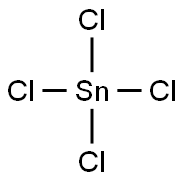General Description
STANNIC CHLORIDE, ANHYDROUS(7646-78-8) is a colorless fuming liquid with a pungent odor. STANNIC CHLORIDE, ANHYDROUS(7646-78-8) is soluble in cold water and decomposed by hot water to form hydrochloric acid with the evolution of heat. STANNIC CHLORIDE, ANHYDROUS(7646-78-8) is corrosive to metals and tissue.
Reactivity Profile
Acidic salts, such as STANNIC CHLORIDE, are generally soluble in water. The resulting solutions contain moderate concentrations of hydrogen ions and have pH's of less than 7.0. They react as acids to neutralize bases. These neutralizations generate heat, but less or far less than is generated by neutralization of inorganic acids, inorganic oxoacids, and carboxylic acid. They usually do not react as either oxidizing agents or reducing agents but such behavior is not impossible. Many of these compounds catalyze organic reactions (ethylene oxide polymerization). Combination of the chloride with turpentine is strongly exothermic, and may lead to ignition, [Mellor, 1941, Vol. 7, 446].
Air & Water Reactions
Fumes in moist air. Reacts with water to form Hydrochloric Acid in dense white fumes [Merck 11th ed. 1989].
Hazard
Evolves heat on contact with moisture. Corrosive liquid
Health Hazard
CORROSIVE and/or TOXIC; inhalation, ingestion or contact (skin, eyes) with vapors, dusts or substance may cause severe injury, burns or death. Fire will produce irritating, corrosive and/or toxic gases. Reaction with water may generate much heat that will increase the concentration of fumes in the air. Contact with molten substance may cause severe burns to skin and eyes. Runoff from fire control or dilution water may cause pollution.
Potential Exposure
Tin tetrachloride is used in the production of blueprints and electroconductive readings, as a bleaching agent for sugar and resin stabilizer.
Fire Hazard
EXCEPT FOR ACETIC ANHYDRIDE (UN1715), THAT IS FLAMMABLE, some of these materials may burn, but none ignite readily. May ignite combustibles (wood, paper, oil, clothing, etc.). Substance will react with water (some violently), releasing corrosive and/or toxic gases and runoff. Flammable/toxic gases may accumulate in confined areas (basement, tanks, hopper/tank cars, etc.). Contact with metals may evolve flammable hydrogen gas. Containers may explode when heated or if contaminated with water. Substance may be transported in a molten form.
First aid
Move victim to fresh air. Call 911 or emergency medical service. Give artificial respiration if victim is not breathing. Do not use mouth-to-mouth method if victim ingested or inhaled the substance; give artificial respiration with the aid of a pocket mask equipped with a one-way valve or other proper respiratory medical device. Administer oxygen if breathing is difficult. Remove and isolate contaminated clothing and shoes. In case of contact with substance, immediately flush skin or eyes with running water for at least 20 minutes. For minor skin contact, avoid spreading material on unaffected skin. Keep victim warm and quiet. Effects of exposure (inhalation, ingestion, or skin contact) to substance may be delayed. Ensure that medical personnel are aware of the material(s) involved and take precautions to protect themselves. Medical observation is recommended for 24 to 48 hours after breathing overexposure, as pulmonary edema may be delayed. As first aid for pulmonary edema, a doctor or authorized paramedic may consider administering a drug or other inhalation therapy.
Shipping
UN2440 Stannic chloride, pentahydrate, Hazard class: 8; Labels: 8-Corrosive material.
Incompatibilities
Slowly forms hydrochloric acid in cold water; fast reaction in hot water and steam. Incompatible with oxidizers (chlorates, nitrates, peroxides, permanganates, perchlorates, chlorine, bromine, fluorine, etc.); contact may cause fires or explosions. Keep away from alkaline materials, water, turpentine, potassium, sodium, ethylene oxide; nitrates, alcohols, amines, chlorine, strong acids; strong bases. Attacks metals, rubbers and some plastics in the resence of moisture.
Waste Disposal
SnCl4: Pour onto sodium bicarbonate; spray with ammonium hydroxide while adding crushed ice; when reaction subsides, flush down drain.
Physical properties
Colorless fuming liquid; corrosive; density 2.234 g/mL; freezes at -33°C; boils at 114.15°C; critical temperature 318.75°C; critical pressure 37.98 atm; critical volume 351 cm3/mol; soluble in cold water, evolving heat; decomposed by hot water; soluble in alcohol, benzene, toluene, chloroform, acetone and kerosene
The pentahydrate is a yellowish-white crystalline solid or small, fused lumps; faint odor of HCl; density 2.04 g/cm3; decmposes at 56°C; very soluble in water; soluble in ethanol.
Purification Methods
SnCl4 fumes in moist air due to formation of a hydrate. Fractionate it in a ground glass still and store it in the absence of air. Possible impurities are SO2 and HCl [Baudler in Handbook of Preparative Inorganic Chemistry (Ed. Brauer) Academic Press Vol I p 729 1963]. It forms a solid pentahydrate [10026-06-9] which smells of HCl and is obtained when the anhydrous salt is dissolved in a small volume of H2O. Also reflux it with clean mercury or P2O5 for several hours, then distil it under (reduced) N2 pressure into a receiver containing P2O5. Finally redistil it. Alternatively, distil it from Sn metal under vacuum in an all-glass system and seal off in large ampoules. SnCl4 is available commercially as 1M solutions in CH2Cl2 or hexane. HARMFUL VAPOURS.
